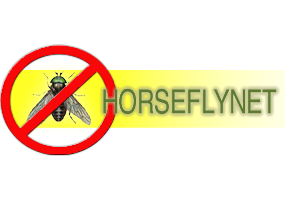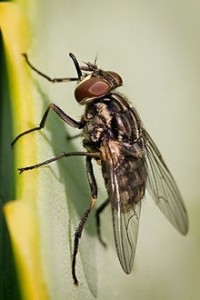-
The house and stable fly are similar in size, color and general appearance. They sometimes are called the barnyard fly. But the stable fly is a bloodsucking fly and aggressive. They bite with the sharp mouth part protruding from the head.
Life Cycle:
Stable fly eggs are only 1 mm long. They develop into larvae and are hard to see because they are translucent. When mature the larvae is a cream color 12 mm long. In the next stage, the pupae, the skin hardens. The completion of stages of development only takes 26 days. Within an hour of development from the pupae stage or final stage the insect can fly, can feed and soon will mate laying 35-80 eggs. They have 11 laying periods before they die, in 4-6 weeks.
Stable flies usually overwinter in the larvae and pupae stages. At night adult flies roost on fences, buildings trees and branches.
Feeding of blood by the adult fly requires 2-5 min. It may require several bites. Three feedings are required after mating.
Control is best done by eliminating the breeding sites:
- organic material such as straw
- manure mixed with straw or bedding
- vegetable or fruit mater
- marine grasses
- grass clippings
- uncovered compost heaps
Straight manure piles are not a good breeding site.
Breeding material on a farm must be scattered. It will dry and deny the fly the moisture it needs in the larvae and pupae stage . Insecticides are only temporary deterrents as flies do not remain around after feeding. The adult fly can fly up to 70 miles for breeding site. Both the male and female feed on blood and are responsible for the nasty bites that horse and human suffer alike.
copy right Horse Fly Net 2012
www.horseflynet.com
The Stable Fly Bites
Call Us at (910) 725-2115 or Email Us at info@horseflynet.com
Horse Fly Net
This see-through breathable screen will last for years. It is made of polyester vinyl coated and heat sealed on the edges with brass grommets about every foot. It has no chemicals added. Our HorseFlyNets only cost approximately $2.00 a square foot for smaller sizes and less for larger. Our product is woven and manufactured in the USA.
HorseFlyNet®
Southern Pines, NC
(910) 725-2115
info@horseflynet.com

